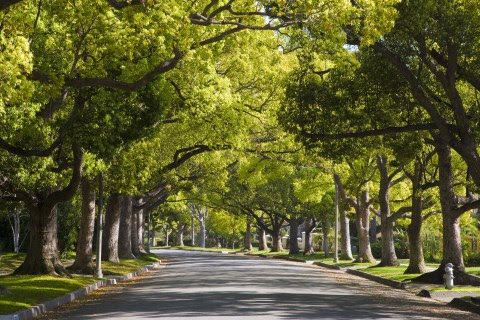By Jay Watson
From large forests to tree-lined city streets, from wooded wetlands to coastal salt marshes, green landscapes are some of humanity’s best allies in addressing threats posed by a warming climate.
Trees, seagrasses and other plants act as the Earth’s lungs, pulling carbon dioxide from the air and emitting oxygen through the process of photosynthesis. The more street trees and healthy forests and marshes we have to sequester carbon, the less there will be in the atmosphere to trap heat like a greenhouse.
Climate change caused by greenhouse gases has led to a greater risk of extreme weather – heat waves, hurricanes, droughts, wildfires and floods – as well as rising sea levels.
To help mitigate climate change, the New Jersey Department of Environmental Protection last week awarded $24.3 million in “Natural Climate Solution Grants” to plant trees in cities and restore existing forests, salt marshes and other coastal ecosystems. This innovative program is one of the first of its kind in the nation.
Dozens of grant recipients – including New Jersey Conservation Foundation – will plant thousands of trees throughout the state and launch projects to boost the carbon-capturing abilities of salt marshes and wetlands along the coast.
The 14 projects will help New Jersey meet its 2050 goal of reducing greenhouse gas levels 80% from 2006 levels. It’s estimated that the new trees and restored marshes will be able to sequester 32,710 metric tons of carbon dioxide equivalent by 2050, roughly equal to the yearly emissions from 7,000 gasoline-powered cars.
The natural climate solution projects are being funded through New Jersey’s participation in the Regional Greenhouse Gas Initiative (RGGI), an 11-state program that establishes a regional limit on carbon dioxide emissions from fossil fuel power plants. Power plants may comply with the cap by purchasing emission “allowances” at auctions; proceeds are used for carbon reduction projects.
Planting trees in urban neighborhoods is an especially appropriate use of RGGI funds, because cities feel the impacts of a warming climate greater than their suburban and rural neighbors. Cities with few trees and large expanses of asphalt and concrete experience the “heat island effect” that causes higher ambient temperatures than in other places.
Planting trees along city streets and in urban parks creates cooling shade, cleaner air, natural beauty and habitat for birds and wildlife. Trees also absorb rainwater, reducing the risk of flooding during the more frequent and violent storms predicted.
Here are some urban tree-planting projects funded by the RGGI climate grants:
- Newark – The city will remove dead trees that have become safety hazards and plant 331 new trees in five target neighborhoods.
- Trenton – New Jersey Conservation Foundation will partner with the City of Trenton, The Watershed Institute, Isles Inc., the Outdoor Equity Alliance, Friends of Hopewell Valley Open Space and the NJ Tree Foundation to plant 1,000 trees throughout the city.
- Camden – A partnership called the Natural Climate Solutions Collaborative, led by the Trust for Public Land and including NJ Conservation Foundation, will plant at least 800 trees in three of the city’s public spaces, and at least 215 trees in public housing complexes in two neighborhoods.
- Atlantic City – The city’s government and local project partners will plant 180 trees along 13 blocks of Atlantic Avenue between Maine and Tennessee avenues.
- Kearny – The city will increase tree canopy and improve stormwater management by planting 300 street trees and building 28 bioswales to absorb rainwater.
- Linden – The city will plant 540 trees on eight flood-prone properties preserved through the state Blue Acres program, and in three city-owned parks and lots.
Non-urban tree projects include the restoration of a 45-acre forest in Princeton, including the removal of invasive plants and the planting of native species; and a project in Readington Township, Hunterdon County, to create a new forest on 11 acres of meadow.
The natural climate solution grants include several “living shoreline” projects to address the loss of vegetated shorelines, beaches, and habitat in the coastal zones along the Atlantic Ocean and Delaware Bay.
For example, the American Littoral Society was awarded funding to protect marshlands at the mouth of the Maurice River in Cumberland County. The project will restore 19.5 acres of tidal salt marsh and create up to 3,500 feet of living shoreline and oyster reefs. The Partnership for the Delaware Estuary will head another project to construct a living shoreline of 1,300 feet along a rapidly eroding salt marsh in the Maurice River.
In three projects in Ocean County, dredged sediment will be added to existing salt marshes to keep them from “drowning” as sea levels rise, and to enhance carbon sequestration.
All of these RGGI projects will add up to a safer and healthier New Jersey that’s a national leader in climate change response.
Making these projects a success will require help from the public, however – especially in urban communities. Planting the new trees is only the first step. Cities will need many local “tree ambassadors” to make sure they’re watered and cared for, especially in the first few vulnerable years after planting. New Jersey Conservation Foundation and partners intend to create a public tree campaign and tree ambassador training project to demonstrate the value of these projects and create a sustainable environment for people and the trees.
For more information about the Natural Climate Solutions Grant Program, visit https://www.nj.gov/dep/climatechange/mitigation/ncs-grant.html. To learn more about projects funded through the Regional Greenhouse Gas Initiative, go to https://www.rggi.org/.
And for more information on preserving New Jersey’s land and natural resources, visit the New Jersey Conservation Foundation at www.njconservation.org or contact me at [email protected].
Jay Watson is a co-executive director of the New Jersey Conservation Foundation, Far Hills.

